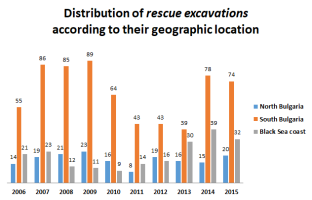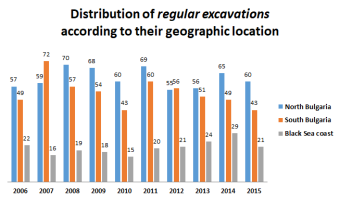

Figure 2: Distribution of field surveys during 2006-2015 according to their geographic location (K. Chukalev/I.D. Cholakov)
Cite this as: Vagalinski, L. 2019 A Decade of Development-led Archaeology in Bulgaria, Internet Archaeology 51. https://doi.org/10.11141/ia.51.4
Bulgaria has been a member of the European Union since 1 January 2007. This membership has significantly expanded funding opportunities for major infrastructure projects in the country. Bulgarian archaeology and the relevant Bulgarian legislation had to adapt quickly to new requirements corresponding to the rules of the European Union. A new Cultural Heritage Act (CHA) was adopted in 2009 [PDF].
The main points of the Act are
The Regulation on Conducting Archaeological Fieldwork was supplemented by a state tariff in 2012, according to which the budget for each type of archaeological field research – rescue or regular/planned, monitoring, excavation or non-destructive research, is established [PDF].


The Cultural Heritage Act and its Regulation on Conducting Archaeological Fieldwork gradually regulated the relationship between investors and archaeologists. The number of cases of destruction of archaeological sites during construction works, despite their scale, has been considerably reduced. The National Coordinator and Methodological Center of Bulgarian Archaeology – The National Archaeological Institute with Museum at the Bulgarian Academy of Sciences – started working in close and positive cooperation with the Ministry of Culture.


The total number of archaeological excavations is presented in Figure 1. If we include field surveys and monitoring (Figure 2) then the total number of archaeological field research projects rises to more than 400 per year. There is a tendency toward balance between rescue and regular/planned excavations as a number (Figure 3). But if we count field surveys and monitoring, most of which relate to development-led archaeology, then the number of rescue field research projects will vastly prevail. NAIM has carried out about 40% of all excavations (Figure 4), which corresponds to the number of archaeologists in NAIM and elsewhere. If we look at the financing of archaeological excavations a stable position can be recognised: the state is in first place, followed by municipalities and then private (Figure 5) As for the funding of rescue excavations, then private financing regularly takes first or second place (Figure 6). It is not the same for regular excavations, where municipality and state financing dominate (Figure 7). When broken down by geographic region, then rescue excavations dominate in South Bulgaria where the economy and population are concentrated since the political changes in the country at the end of 1989. Regular excavations prevail in North Bulgaria (Figure 8) owing mainly to the tradition of archaeological survey of medieval Bulgarian capitals (Pliska, Preslav and Veliko Tarnovo) and of the Roman Lower Danube Limes. In financing terms, there is a strong predominance of state developers involved in rescue archaeological investigations (Figure 9).






The Cultural Heritage Act (2009) is the most frequently changed law in recent Bulgarian history, including that relating to archaeology and the Archaeological Fieldwork Regulation (2011). The archaeological heritage sector is among the few economic areas that has not yet been privatised, and therefore is causing an appetite for profit-seeking. The frequent amendments of the Cultural Heritage Act and its regulations lead to unnecessary tensions among archaeologists.
Furthermore illegal excavations (treasure hunting) continue to be the greatest threat for Bulgarian archaeology as a whole. According to the Bulgarian police, about 30,000 persons are permanently engaged in this criminal activity. In certain periods after 1989, their number increased significantly. These candidates for fast and easy money systematically destroy archaeological heritage in the country. Thus both history/historical memory and a major share of its cultural tourism potential are irreversibly lost to the country.
There is, in addition, a permanent latent discontent among large private and public investors because of the legal obligation to pay for archaeological research according to a state-determined tariff and to take the archaeological heritage of the country into consideration. Attempts are periodically made to change the well-functioning existing system of Bulgarian archaeology, aiming for a drastic reduction in incurred costs for rescue archaeological research. Large investors (public and private) do not plan rescue archaeological research in time. Research is commissioned relatively late within building schedules, resulting in tension between investors and archaeologists.
Often investors and construction companies have sought to blame the archaeological research for delays actually caused by their own organisational weaknesses. Through the common efforts of media and archaeologists, this bad practice is limited and today Bulgarian society is less likely to be misled/manipulated to the detriment of Bulgarian archaeology.
The lack of a coherent common policy or regulations in the European Union with regard to cultural heritage, and in particular towards archaeology, allow Bulgarian civil servants to refer incorrectly to Brussels rules. Therefore additional unjustified requirements are imposed on contractor-archaeologists. While the clerk tries to avoid responsibility, this can lead to difficulties implementing infrastructure projects of national importance.
The main question is whether private archaeological units will be permitted to operate. The current legislation does not allow this. It also rejects a recently launched idea of setting up archaeological NGOs to carry out rescue archaeological projects and attempts to introduce private entities into them will continue. Financially strong groups of investors, building contractors and private collectors, looking for profits through and at the expense of archaeology, stand behind them. Of course, they have influence in all three authorities ‒ legislative, judiciary and executive. It is logical that they will prevail sooner or later, but it won't be for the good of the rich archaeological heritage in Bulgaria. Wherever in Europe so-called commercial archaeology has been allowed, as a rule, it has led to serious problems. Private archaeological companies are winning tenders for rescue archaeological research by cutting prices. As a consequence, they cannot maintain acceptable standards of archaeological fieldwork. The link between fieldwork and publication of the results is also broken. Museums do not accept findings because of poor documentation. As a result, Europe is permanently and irrevocably losing its history, but also its economic prospects. And this is, to put it mildly, strange, because a survey published in December 2017 showed that 80% of European citizens think cultural heritage is important and 79% think Europe's cultural heritage creates jobs in the EU (European Commission 2017). According to another study of 2017, 90% of Europeans regards archaeology as useful; 86% consider having archaeological remains is an advantage for a town; 64% of Europeans think the discipline should be taught in school; most Europeans think the management of preventive archaeology (development-led archaeology) should be entrusted to the public sector to 'avoid serving particular interests'; to 'guarantee the same norms in all regions'; or 'because only the national government can guarantee the preservation of heritage' (Marx et al. 2017). Specifically for Bulgaria, the high number of illegal excavations is an actual precondition for their effectively becoming legalised through private archaeological organisations.
Supranational rules on cultural and historical heritage and, in particular, those relating to archaeology, obligatory for the European Union, could restore the equilibrium between the interest of investors and that of archaeologists. At present this socially beneficial balance is severely biased in favour of the former. Exceptions such as in Bulgaria and Denmark do not change the gloomy situation of modern European rescue archaeology. We can restore economy and even population, but not archaeological heritage once lost!
Internet Archaeology is an open access journal based in the Department of Archaeology, University of York. Except where otherwise noted, content from this work may be used under the terms of the Creative Commons Attribution 3.0 (CC BY) Unported licence, which permits unrestricted use, distribution, and reproduction in any medium, provided that attribution to the author(s), the title of the work, the Internet Archaeology journal and the relevant URL/DOI are given.
Terms and Conditions | Legal Statements | Privacy Policy | Cookies Policy | Citing Internet Archaeology
Internet Archaeology content is preserved for the long term with the Archaeology Data Service. Help sustain and support open access publication by donating to our Open Access Archaeology Fund.